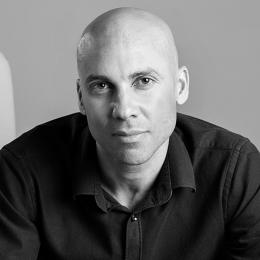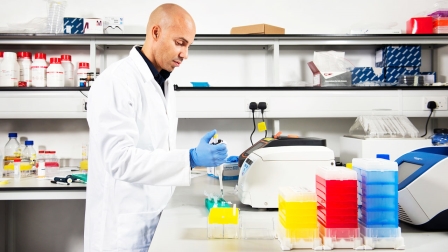Microsoft’s “Biological Computing” Lab Aims To Fight Diseases By Reprogramming Cells
Microsoft’s researchers don’t talk about “curing” cancer. Instead, they are aiming to “solve” it.
The technology behemoth is best known for its operating systems and business software, and since 2014, under CEO Satya Nadella, it’s focused much of its energy on plotting a future for mainstay products such as Windows and Office. But the company has also quietly built up a presence in medical research. In Cambridge, U.K., it has 150 scientists and software developers working on a wide variety of projects at its little-known “biological computation” unit, which includes a newly installed wet lab. The company says its eventual goal is to make cells into living computers that could someday be programmed—and even reprogrammed—to treat diseases like cancer. In the near term, it is building computer-modeling tools to assist pharma companies in drug discovery and development.

The lab is positioning itself at the intersection of machine learning, computer-aided design, mathematics, and biology. For decades, these disciplines were relatively disparate, but that’s beginning to change with the advent of such fields as bioinformatics. Microsoft’s team specializes in biological modeling, a still-nascent branch of systems biology that involves using advanced computation to map the complex interactions at work inside a cell.
“The field of biology and the field of computation might seem like chalk and cheese,” says Chris Bishop, head of Microsoft Research’s Cambridge-based lab, using a Britishism to convey their obvious differences. “But the complex processes that happen in cells have some similarity to those that happen in a standard desktop computer.”
The emerging field of biological modeling caught the attention of the scientific community in 2012 when researchers at Stanford University developed the first complete computer model of an organism, the tiny parasite Mycoplasma genitalium. That research brought to light a problem that still plagues biologists: There is no shortage of cellular data drawn from experiments, but this data can’t be properly understood until it can be brought in one place. Microsoft’s senior researcher Jasmin Fisher describes this process as “connecting the puzzle pieces.”
Proponents of the field see potential for a variety of medical uses. In response to the Stanford development, National Institutes of Health director James M. Anderson described these kind of computational models of cells as having the “potential to advance our understanding of cellular function and, ultimately, to inform new approaches for the diagnosis and treatment of disease.”
Reprogramming Cancer
In exclusive interviews with Fast Company, Microsoft’s scientists provided an inside look at two ambitious projects of their own that are currently under way that treat cancer as an information system that can be programmed. The company says these efforts are not connected to Microsoft cofounder Paul Allen’s $100 million-funded Allen Institute for Cell Science, which is based in Seattle.
The first is an effort to model the computational processes that happen within the cell. The second, which is headed up by Fisher, is the development of a tool for scientists and researchers to create their own computer models of biological systems. Pharmaceutical giant AstraZeneca is partnering with Fisher’s team on the latter project, dubbed Bio Model Analyzer, an effort to better understand drug interactions and resistance in patients with chronic myeloid leukemia.
Fisher, a neuroimmunologist and computer scientist by training, says she joined Microsoft Research in 2007 to focus on the deep, fundamental questions like: “Why do cells behave as they do?” and “Why do they decide to die, migrate, or divide?” Her team’s work isn’t data analysis, she stresses, but it requires thinking about biological mechanisms as programs. From there, researchers use computer programming languages to compare the biological processes of a healthy cell with the abnormal processes that occur when disease strikes.
For AstraZeneca’s Jonathan Dry, the Bio Model Analyzer is shaping up to be useful in better understanding which patients will form a resistance to a drug therapy. If the company can better predict these outcomes, he explains, it could suggest a step-in drug of sorts that could be used to overcome the resistance. It is also potentially useful in determining which potential therapies are worth pursuing. “I’m hoping this is the beginning of changing the way we do drug discovery,” he says. “We could … test all our ideas in a system like this, and determine the experiments that will have the best chance of success.”

Another project, led by the head of Microsoft Research’s Bio Computation Group, Andrew Phillips, is an effort to understand how cells make decisions, including those that trigger cancer. The goal is to develop a programming language to model the relationships between the biological components, and potentially control how cells behave. If that’s possible, Phillips says, a response could be triggered within a cell to fight the disease before it spreads.
Experts say this kind of a moonshot is plausible, but hurdles abound. “The dream is to model everything, no experiments required,” says Gabriel Otte, a computational biologist and biotech entrepreneur. But he stresses that it’s still very early, and these tools are most useful today to create high-level models of drug responses. Bringing this type of system to scale will require that researchers prove that it is both accurate and robust—and that will take time.
According to Phillips, another major challenge for his team is that computers were developed by humans; cells and the diseases that control them are the result of many, many years of evolution. That requires a computational model that can deal with an extreme level of complexity. ‘You can think of computing of being a sequence of instructions like a recipe,” he says. “In a biological setting you have a chemical soup.”
Fast Company , Read Full Story
(23)


